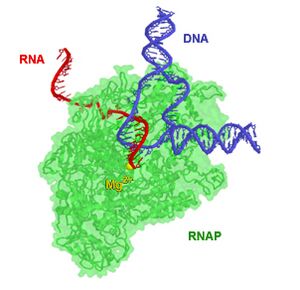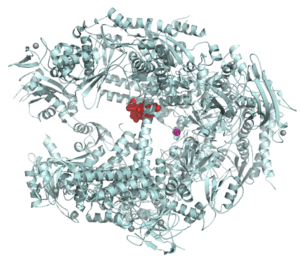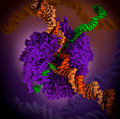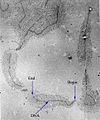RNA polymerase facts for kids
RNA polymerase (RNAP) is a special protein, called an enzyme, that helps make copies of genetic information. This process is called transcription. In 2006, Roger D. Kornberg won the Nobel Prize in Chemistry for showing clear pictures of how RNA polymerase works when it's making these copies.
With help from other molecules, RNA polymerase creates messenger RNA (mRNA) from a strand of DNA. This is its main job, but it also makes other important molecules:
- Messenger RNA (mRNA): These molecules carry instructions from DNA to build proteins in the cell's ribosomes.
- Non-coding RNA: These are types of RNA that do not carry instructions for making proteins. They have other important jobs.
- Transfer RNA (tRNA): These molecules bring specific building blocks (amino acids) to the ribosomes to help create proteins.
- Ribosomal RNA (rRNA): This is a key part of the ribosomes, the cell's protein-making factories.
- Micro RNA: These tiny RNA molecules help control how genes work.
- Catalytic RNA (Ribozyme): These are RNA molecules that can act like enzymes, speeding up chemical reactions.
RNA Polymerase in Eukaryotes
Eukaryotes are living things like animals, plants, and fungi. Their cells have a special part called the nucleus where most of their DNA is stored. Inside the nucleus, eukaryotes have different types of RNA polymerase, each with a specific job:
- RNA polymerase I makes a type of rRNA that forms the main parts of the ribosome.
- RNA polymerase II makes the first versions of mRNA and most snRNA and microRNAs. This is the most studied type. It needs other helper proteins, called transcription factors, to attach to specific starting points on the DNA called promoters.
- RNA polymerase III makes tRNAs, another type of rRNA (called 5S rRNA), and other small RNA molecules found in the nucleus and cytosol.
- RNA polymerase IV makes siRNA in plants.
- RNA polymerase V also makes RNAs involved in siRNA-guided heterochromatin formation in plants.
Eukaryotic chloroplasts (which are in plant cells and help with photosynthesis) have an RNA polymerase that is very similar to the one found in bacteria. Chloroplasts also have a second, different type of RNA polymerase.
Eukaryotic mitochondria (the "powerhouses" of the cell) contain an RNA polymerase that is not related to the others.
Scientists have studied the structures of DNA and RNA polymerases. They found that even though both use a magnesium ion to help them work, they are actually very different. This means these two groups of enzymes likely developed separately a long time ago in the early history of cells. One group led to the DNA polymerases we know today, and the other led to all the RNA polymerases.
Images for kids
-
An electron-micrograph of DNA strands decorated by hundreds of RNAP molecules too small to be resolved. Each RNAP is transcribing an RNA strand, which can be seen branching off from the DNA. "Begin" indicates the 3′ end of the DNA, where RNAP initiates transcription; "End" indicates the 5′ end, where the longer RNA molecules are completely transcribed.
-
T7 RNA polymerase producing a mRNA (green) from a DNA template. The protein is shown as a purple ribbon (PDB 1MSW)
See also
 In Spanish: ARN polimerasa para niños
In Spanish: ARN polimerasa para niños







